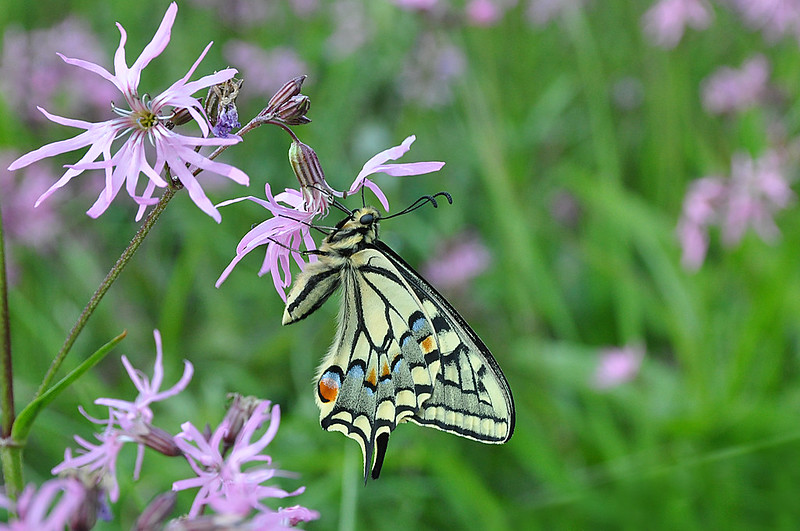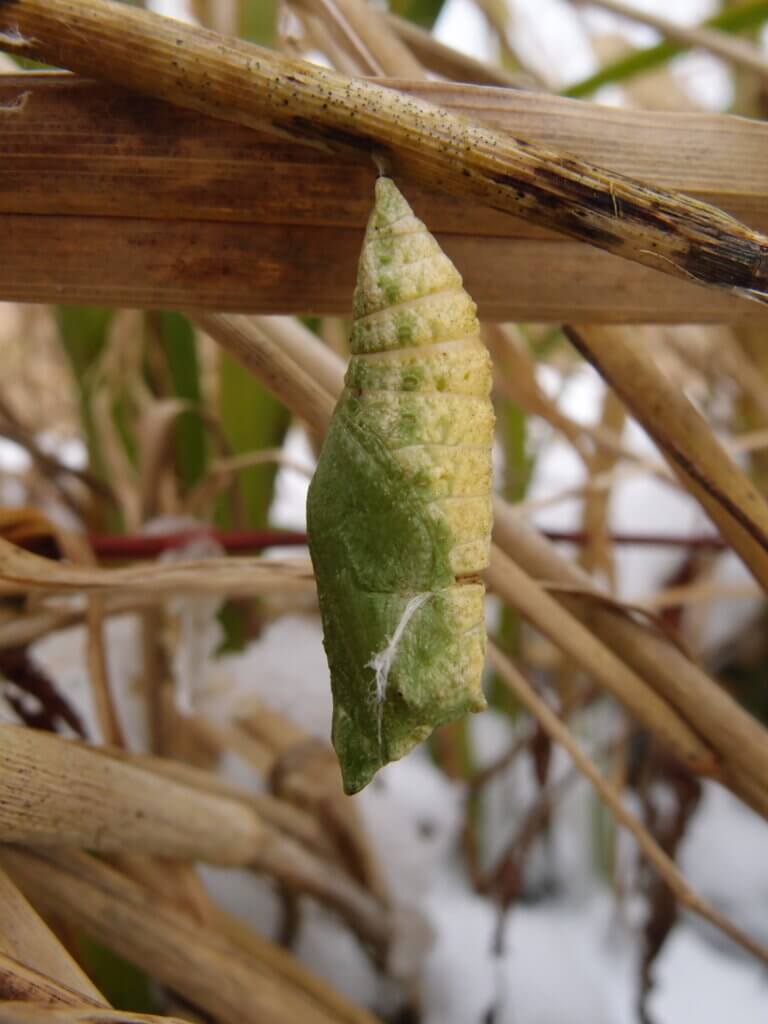
The British subspecies of the Swallowtail is pretty much restricted to the Norfolk Broads and is a species whose numbers have increased in recent years although its distribution may have contracted. It’s a species of conservation concern and is the subject of conservation measures and studies.
Kevin Radley and Hannah Breach are carrying out an independent study of overwintering pupae at a nature reserve in an SSSI which is part of The Broads Special Area of Conservation (although I am keeping the exact location secret in deference to the site’s owners, a conservation body).
Their study involves finding Swallowtail pupae and monitoring their survival. This winter, Kevin and Hannah located 18 Swallowtail pupae; this one (pictured below) was located in December 2020. Amazing isn’t it?

Kevin and Hannah set up a trail cam to monitor this pupa and on 18 March along came a Pheasant and gobbled it up! The video below is amazing although I had to look at it several times before I was sure what I was seeing – it all happens so quickly (inside the first 4 seconds of the video)!
This is the first photographic evidence of a Pheasant predating a rare butterfly pupa to my knowledge but if there are lots more I’d love to hear about them.
One pupa being predated doesn’t prove anything – except, for the first time, that such events do happen – but Pheasant numbers are high, I am told, on this site and that is certainly a cause for concern.
This pupa, and most pupae, are located at just the height which will bring them most easily to a wandering Pheasant’s attention and be within easy pecking reach. It is the type of incident that supports the concerns of Wild Justice and strengthens the need for DEFRA and Natural England to act strongly on releases of non-native gamebirds on or near designated sites such as this one – a site which is an SSSI and SAC. No Pheasants are released on this site – their presence is due to the scale of release on adjacent farmland.
DEFRA’s proposed protection measures which exhort gamebird shoots to stick to the existing industry guidelines on densities in release pens (which are currently widely ignored) will do nothing to reduce any impacts of gamebird predation of invertebrates of conservation concern on this and similar sites. There is no suggestion that the existing releases are above the best-practice guidelines – they might be, but no-one is suggesting that here (nobody knows). DEFRA’s proposed measures will not necessarily limit overall numbers of non-native gamebirds released and will not reduce their ingress into sites of conservation concern.
DEFRA should do more.
[registration_form]
This is just another confirmation if one was needed that pheasants are a major introduced predator on most of our invertebrate wildlife and on a quite a bit of our smaller vertebrate wildlife. Such as young reptiles and ground nesting birds.
Pheasants are not native to Europe but certainly in the Chilterns and in Oxfordshire generally they are all over the place, probably one of the commonest, if not the commonest bird.
However we continue to have Defra and the shooters denying reality that pheasants only stray half a kilometre from their release point. Complete and utter tosh. Their numbers are such and they are so ubiquitous that they must be having a major adverse effect on the ecological balance of nature.
Get real Defra.
Sites of conservation concern? That’ll be our garden then.
We have warning road signs in our village to prevent the squishing of frogs. When we arrived 17 years ago there were neighbours that used to go out at night with buckets to collect them off the road. There were quite literally hundreds. Now we don’t see any, but do see many more pheasants.
We put bird seed out on our back door step only to see a male pheasant with his two brides come along to feast. Last year I found a clutch of sixteen eggs in long grass by our large pond. It’s a wildlife pond. No fish. We do still have newts but the frogs and toads have all but disappeared.
We are over a kilometre from the nearest release site but only half a kilometre from our local nature reserve. No surprise that that is suffering too.
In a rural village all we are left with is pheasants and two defunct road signs. And yes, I have told the useless DEFRA that.
Any doubters are welcome to ask Mark to view the photos I have just sent him.
Warning signs do not prevent anything
I am a great dislike of the pheasant in our countryside in numbers, beautiful though the males are. In conversation or on social media I have said, using the terminology of the shooting fraternity, that the only vermin in our countryside are the criminals who kill protected wildlife and the damned pheasants they think they are protecting. The idea these birds don’t wander more than 500m from release pens is frankly rubbish and I’m sure the shooters know this even if DEFRA don’t. I’ve seen lines of guns waiting for pheasants in a drive who were 2km from the relevant release site. These birds are a menace to everything small enough to be swallowed, if you doubt that watch some of their free range brethren, the chicken, it might surprise you what they eat. Never mind 500m there should be no releases from within a minimum of 3km of any nature reserve or site with ANY designation. And No closed season on the damned things anywhere.
Even chickens with spectacular featheriness like Laced Wyandottes are just chickens and as such are bundles of unpleasant involuntary behaviours covered in feathers especially if they find themselves on a perch next to a moulting chicken which they soon reduce to a skelington if it has so much as a speck of blood on it but with regard to pheasants there would not be so many of the phuckers if people with guns stopped missing them although I wouldn’t mind so much if they did something useful like ate more voles so I would get to eat more of the broad beans that I sow
How come, during the latest bird flu outbreak, the Avian Prevention Zone (where all kept birds including game birds were housed indoors or under netting) was 3km and the Monitoring Zone was 10km. It seems odd if poultry and game birds have no chance of being infected with Avian Flu by wild birds if Defra sincerely believes there is no significant risk to wild birds beyond 1/2km and vice versa. It just strikes me as irrational. If commercial birds and pet birds face the potential horror of being infected by wild birds suffering from bird flu and their faeces etc then it seems to me that, logically, the risk of disease transfer to wild birds and other impacts from game birds (including non-native game birds) should apply both ways. The Protection Zones of SSIs etc should be 3km, not 1/2km!
It seems to me that the precautionary principle applies to threats to commerce from wildlife (birds, badgers etc) but not the other way round. Wildlife is offered minimum protection from the impacts of interactions between commercially bred animals and birds yet business enterprises are offered much tighter protections from potential wildlife impacts. The only reason, it seems to me, that wild bird Avian Flu carriers are not slaughtered (like badgers) to prevent disease spread is that it would be impossible to achieve – hence actual regulations on biosecurity!
If my logic is wrong, could someone clarify things for me. Thanks.
Rewilding has its many fault lines, all of them based on human aspirations, [Mark writes – I’ve deleted the rest of this comment, very interesting though it is because the author keeps slagging off nature conservation organisations gratuitously and he never divulges the location of this great rewilding project of which he is in charge. I wonder whether it exists. I’ve offered him a guest blog We’re coming to the end of this blog and I’m feeling that he should put up r shut up.]
I agree with Paul that what the chicken will eat is a good guide for what pheasants will too, and that’s bloody scary – I’ve seen film of chickens killing a snake. I’ve heard of a fritillary population in a woodland being eaten out by pheasants and remember hearing that this happened with a population of sand lizards. IMHO a factor that’s rarely mentioned, but could be crucial is that if pheasants are receiving supplementary feed that means they can eradicate natural food sources in the way a genuinely wild animal like an otter or goshawk just couldn’t. This could very well be maintaining population densities that mean even butterfly pupa rarely escape their attention. This is not good news for those who want big pheasant releases and if the very next time what’s caught on film happens to be a pheasant guzzling down a lapwing chick then it will be interesting to see how G.W.C.T and BASC among others try to palm it off as a non event.
I remember a head Grouse keeper I knew well instructing his under keepers to kill all Pheasants on the moor in spring because they eat eggs and very young Red Grouse if they are not defended well by their parents and the same with Lapwings. His replacement when he retired did do this and the Lapwings have gone from much of the edge of this moor but the pheasants are still there!
There is film footage from SpringWatch of a pheasant eating all of the recent hatchling grass-snakes from a nest. The bird came back several times to get every single individual. Can’t remember the date, but it was from the period they were based in mid-Wales.
A friends grandfather worked in the brecks way back, they used to shoot the thick – knees because they ate pheasant and partridge eggs and chicks. No doubt this saved a good many snakes, reptiles , insects etc:, from these voracious
predators. A fact often forgotten.
Trapit,
And your point is? Stone Curlews are in the Brecks naturally and Pheasants, in their overwhelming unnatural numbers are not!
I know this might be hard for you to understand, but releasing millions of non native birds into the environment every year, which are known to cause ecological damage, is clearly unacceptable. The fact that we don’t know the scale of this ecological damage is unbelievable!
Thank you for explaining the difference Mathew.
The Suffolk wildlife trust Fox fritillary meadow lost nearly every flower to Phasants one year.
Strange! What year would that have been Andrew? I have known that site the area and it’s wildlife very well for many years. Well worth a visit, and if you get a chance talk to the owners how they manage it and what they and others nearby do for conservation.